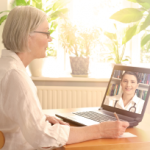
Image Credit: Sergey Nivens/shutterstock.com
“Telemedicine covers a variety of services, but it basically is defined as providing patient services using telecommunications,” says Jonathan Linkous, chief executive officer of the American Telemedicine Association. “With time, the cost of both the technology and the communication services went way down, and we are just beginning to see the use of digital phones, computers and tablets in this area.”
Remote Specialty Care Growing
Perhaps the largest area of growth will be providing specialty care remotely. New technologies allow the use of some basic instruments, such as a stethoscope, otoscope and dermascope, to provide patient care over distances. The adoption of electronic health records allowing physicians access from their offices has made imaging and laboratory values available over the Internet or phone lines.
However, integrating these technologies into rheumatology presents some concerns to physicians in the specialty—not the least of which is the importance of touch in the diagnosis and treatment of patients.
Integration into Touch-Intensive Specialty
“How to integrate telemedicine into a specialty largely dependent on touch is the central question,” says Daniel A. Albert, MD, professor of medicine and pediatrics in Rheumatology at Dartmouth College Geisel School of Medicine in Hanover, N.H. “Figuring out how such a patient examination-specific discipline can cope with the inability to touch the patient is one of the first things to be overcome.”
Most telemedicine projects work around this concern by having a “presenter” with the patient. Usually a specially trained RN, LPN or medical assistant, the presenter gets the person checked in, obtains vital signs and asks about any concerns or complaints. They also help with assessing such things as range of motion, tenderness or warmth of joints, locating rashes, evaluating muscle strength, etc. Presenters can also work the technologies that relay the results of using the stethoscope, zoom the cameras if closer looks are needed or use a handheld camera for more difficult to reach areas.
Addressing Access Issues
In many ways, telemedicine addresses access issues. When deciding if practicing remotely is a viable alternative, both the practice and participating physicians should look at their geographical area to find underserved areas. One of the best uses for telemedicine can be opening up opportunities for specialist treatment to patients that have not had them before. Telemedicine helps reduce, and to some extent eliminate, the number of patients who are lost to follow-up.



